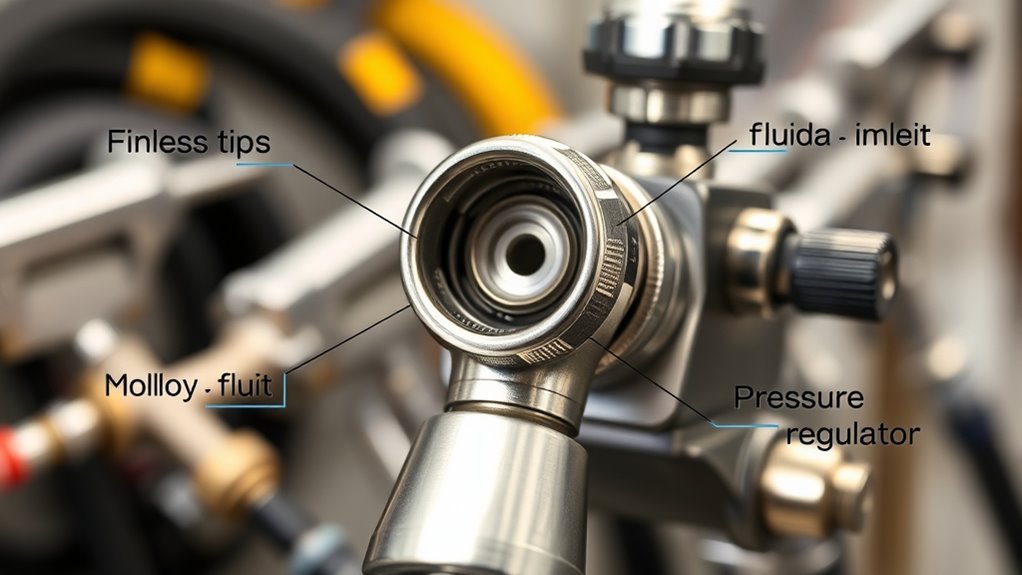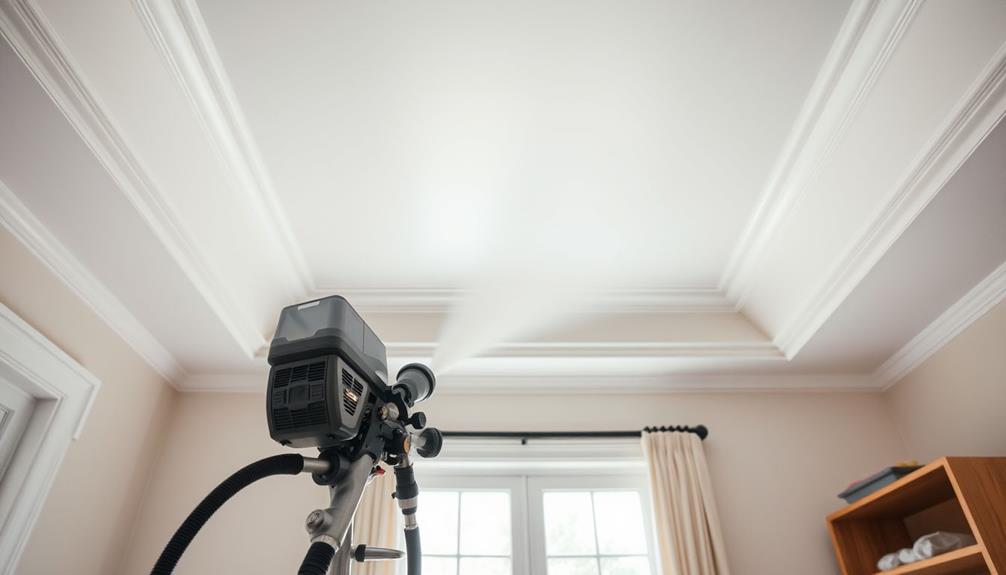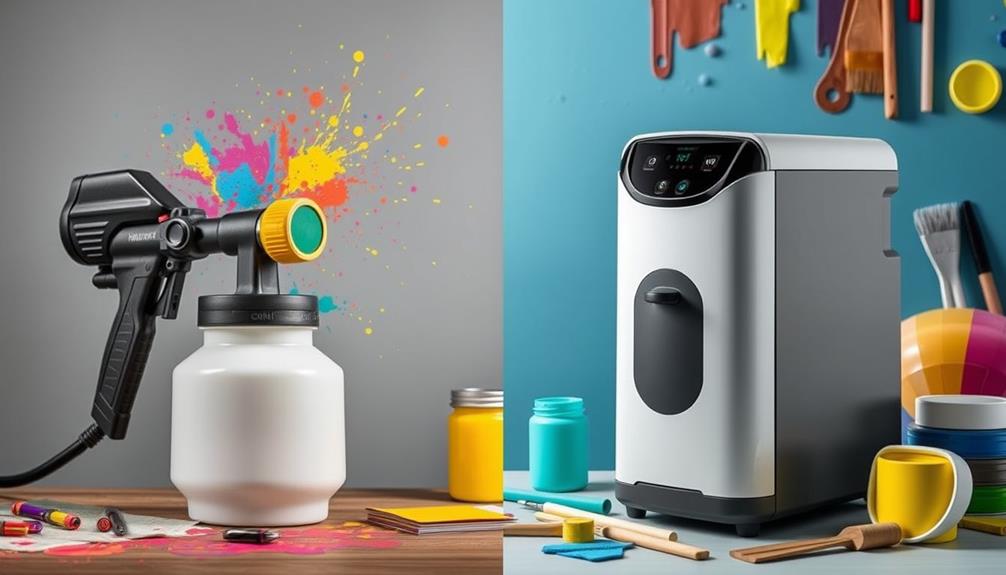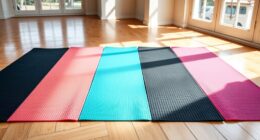Understanding airless paint sprayer terminology is key to mastering your equipment. You’ll learn about how the sprayer uses high pressure to atomize paint and how the pump drives this process. Nozzle types and spray patterns help you control finish quality. The hose material affects handling and durability, while pressure and flow rate influence coverage. Proper technique and maintenance guarantee smooth operation. Keep exploring to discover how these terms can boost your painting skills.
Key Takeaways
- An airless paint sprayer uses high pressure to atomize paint for even, efficient application.
- The pump drives paint through the system, maintaining consistent pressure and flow for quality results.
- Nozzles and spray patterns are adjustable to control paint dispersion, coverage, and finish quality.
- Proper hose selection and maintenance ensure system durability, maneuverability, and optimal performance.
- Pressure regulation and technique are vital for preventing overspray, ensuring smooth, professional coatings.
What Is an Airless Paint Sprayer?

Have you ever wondered how professional painters achieve smooth, even coats quickly? An airless paint sprayer is a powerful tool that makes this possible. Unlike traditional brushes or rollers, it uses high pressure to atomize paint, creating a fine spray. This allows for efficient application methods, covering large surfaces evenly and quickly. With an airless sprayer, you can easily change paint colors without much hassle, switching between different hues for various projects. The sprayer’s pressurized system pushes paint directly from the container through a hose and out the nozzle, providing consistent coverage. This device is ideal for both interior and exterior work, saving you time and effort while delivering a professional finish. Knowing how it works helps you make the most of its capabilities. Additionally, understanding paint atomization can help you optimize spray techniques for a smoother finish.
Understanding Pressure and Flow Rate

Understanding pressure and flow rate is essential for mastering your airless paint sprayer. You need to monitor pressure fluctuations closely, as inconsistent pressure can cause uneven spray patterns and drips. Maintaining steady pressure guarantees your paint is atomized properly, resulting in a smooth, uniform finish. Flow rate determines how much paint is delivered per minute; too high can lead to overspray, while too low might cause uneven coverage. Adjust your pressure settings carefully to achieve flow consistency, especially when working on large surfaces or different paint types. Remember, fine-tuning these factors helps you control spray quality, reduces waste, and speeds up your project. Developing a good sense of pressure and flow management is key to professional results with your airless paint sprayer. Additionally, understanding the pressure regulation system within your sprayer can help prevent common issues and ensure optimal performance.
Nozzle Types and Spray Patterns
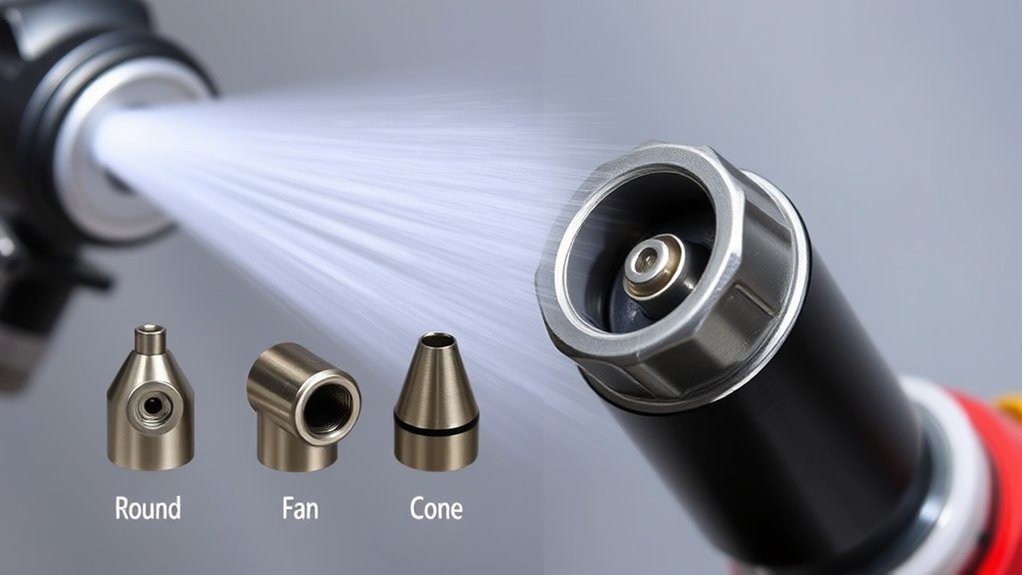
Nozzle shapes and spray patterns directly affect how your paint is applied and the finish you achieve. Different nozzle designs produce various spray patterns, such as narrow or wide fan shapes, to suit different surfaces. Understanding these options helps you select the right nozzle for your project and get the best results. For example, choosing the appropriate spray tip can minimize overspray and improve overall application quality.
Nozzle Shape Variations
Different nozzle shapes and spray patterns considerably impact the quality and efficiency of your painting job. The shape influences how the paint is atomized and dispersed, affecting coverage and finish. Nozzle size and spray angle are key factors; a larger nozzle size delivers more material, while a wider spray angle covers larger areas quickly. Conversely, a narrower spray provides precision. Understanding regional legal resources can also help if you encounter issues with contractor licensing or disputes related to your painting project.
Spray Pattern Options
Have you ever wondered how choosing the right nozzle type can affect your painting results? Your spray pattern options and nozzle adjustments determine coverage, finish, and efficiency. Different spray patterns, like wide, narrow, or circular, suit various surfaces and project sizes. Adjusting the nozzle can change the spray width and atomization, helping you control paint flow and reduce overspray. Here are some key points to consider:
- Wide spray patterns are ideal for large, flat surfaces.
- Narrow patterns work better for detailed areas.
- Circular patterns are useful for spot repairs.
- Proper nozzle adjustments ensure an even, professional finish.
- Understanding spray pattern options also involves selecting the appropriate nozzle types, which directly influence spray quality and application technique.
Selecting the correct spray pattern options and making precise nozzle adjustments allow you to achieve consistent, high-quality results with your airless paint sprayer.
The Role of the Pump in Painting

The pump is the core component that drives paint through your sprayer, so understanding how it works is key to achieving a smooth finish. Proper pressure regulation guarantees consistent spray patterns and prevents overspray or clogs. Regular maintenance keeps your pump running efficiently and extends its lifespan, saving you time and money. Additionally, familiarity with newborn sunscreens and their proper application can serve as a useful analogy for understanding the importance of precise control and safety in your equipment.
Pump Mechanics and Function
At the core of an airless paint sprayer’s operation, the pump is responsible for generating the pressure needed to push paint through the nozzle. Its mechanics revolve around converting motor energy into fluid movement, relying heavily on fluid dynamics to guarantee smooth flow. Pump efficiency plays a key role, affecting how well the system maintains consistent pressure and reduces paint waste. Additionally, the design of the pump can influence the overall tuning of the sprayer, impacting performance and durability.
- Reciprocating or piston action controls fluid intake and expulsion.
- Fluid chambers store and move the paint efficiently.
- Valves regulate flow, preventing backflow and leaks.
- Seals and pistons minimize pressure loss and maintain system integrity.
Understanding these components helps you grasp how the pump maintains ideal performance and consistent spray quality.
Pressure Regulation Importance
Maintaining proper pressure is essential for achieving a smooth, even paint finish with an airless sprayer. Pressure stability ensures the spray pattern stays consistent, preventing drips or uneven coats. The pump plays a key role in this process by maintaining the correct pressure throughout your project. Regulation devices, such as pressure regulators or control valves, help you fine-tune this pressure, ensuring it stays within ideal ranges. Without proper regulation, pressure fluctuations can cause overspray, uneven coverage, or paint waste. By understanding how your pump and regulation devices work together, you can keep the pressure stable, resulting in a professional-looking finish. Proper pressure regulation ultimately leads to better control, less mess, and a more efficient painting process. Choosing the right materials for your pump and regulation devices is also crucial to ensure consistent performance during your project.
Pump Maintenance Tips
Proper pump maintenance is essential to keep your airless sprayer performing at its best. Regular upkeep guarantees consistent paint flow, prevents clogs, and extends your equipment’s lifespan. Start by checking paint viscosity; thin it properly to avoid strain on the pump. Always verify solvent compatibility to prevent damage to internal seals and components. Keep the pump clean by flushing it thoroughly after each use. Additionally, inspect seals and filters regularly for wear and replace them as needed. Use the right cleaning agents compatible with your pump to avoid corrosion. Proper maintenance minimizes downtime and guarantees smooth operation, ensuring your projects stay on schedule. Remember, attentive pump care is key to achieving professional-quality results every time.
Types of Hoses and Their Uses

Choosing the right type of hose is essential for efficient and safe use of an airless paint sprayer. The hose’s durability and flexibility determine how well it handles your project and resists wear. Selecting a hose with proper energy efficiency properties can also contribute to overall system performance and longevity.
| Hose Type | Best Use | Key Feature |
|---|---|---|
| Rubber Hose | Heavy-duty jobs, rough conditions | High durability, flexible |
| Polyurethane Hose | Fine finishes, detailed work | Excellent flexibility, lightweight |
| Hybrid Hose | Versatile, general use | Combines durability & flexibility |
Rubber hoses are tough but less flexible, ideal for demanding tasks. Polyurethane hoses excel in maneuverability for detailed work. Hybrid hoses offer a balanced option, perfect for varied projects.
Tips for Proper Spray Technique
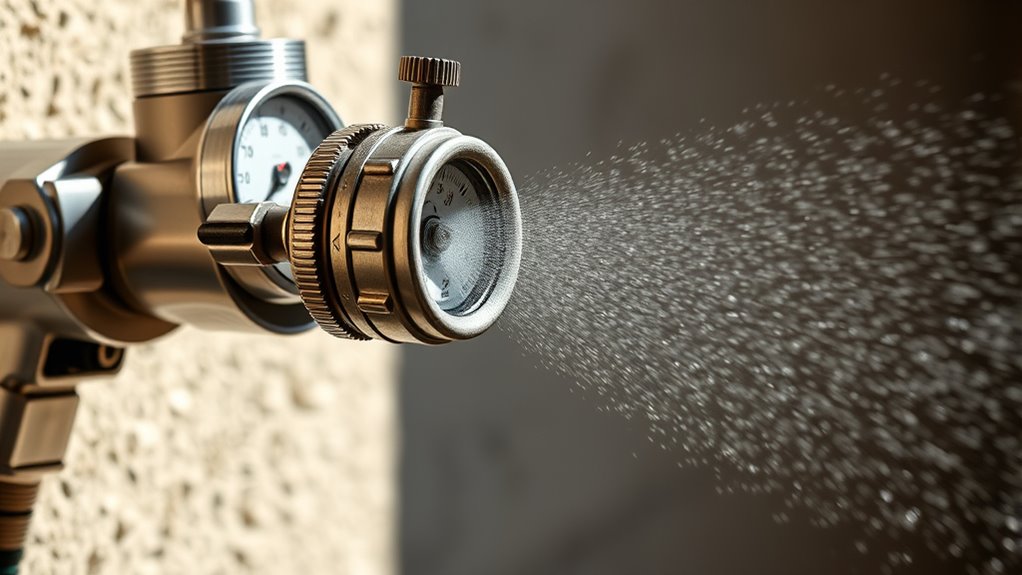
Using the right hose type can make a noticeable difference in your spray results, but mastering your spray technique is equally important. To achieve smooth, even coverage, focus on your brush techniques and maintain proper paint consistency. Keep your spray movements steady and overlapping slightly for uniform application. Maintain a consistent distance from the surface, usually 12-18 inches, to prevent drips and uneven coats. Adjust your pressure settings to match the paint’s viscosity, ensuring it flows smoothly. Practice controlling your trigger for a steady release, avoiding starts and stops. Regularly check your spray pattern and adjust as needed to prevent runs. Proper technique and attention to detail are key to a professional finish. With proper technique, you’ll achieve professional-looking results more efficiently.
Maintenance and Troubleshooting Terms
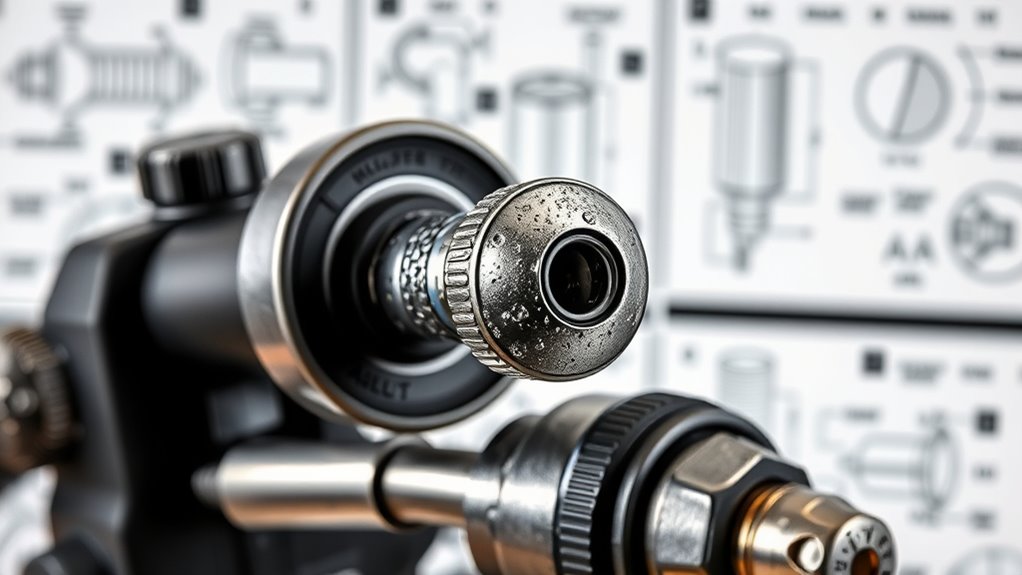
Ever wonder what common maintenance and troubleshooting terms mean when working with airless paint sprayers? Understanding these terms is key to maintaining paint sprayer safety and ensuring peak performance. “Clogged tip” refers to paint buildup blocking the spray pattern, requiring cleaning or replacing the tip. “Pump pressure” involves adjusting equipment calibration to match the project’s needs, preventing issues like overspray or uneven coverage. If you notice inconsistent spray, it might be a “pressure imbalance,” which can be fixed by checking hoses and connections. Regular maintenance includes cleaning filters and inspecting hoses for wear, helping you avoid costly repairs. Troubleshooting involves identifying these issues quickly, promoting safe operation and accurate paint application. Knowing these terms keeps your equipment running smoothly and extends its lifespan. Additionally, understanding the proper exfoliation techniques can enhance your surface preparation, leading to more efficient painting results.
Frequently Asked Questions
How Do I Choose the Right Airless Sprayer for My Project?
To pick the right airless sprayer, consider your project size and the surface you’re covering. A sprayer with a higher capacity suits larger jobs, while smaller projects need less power. Pay attention to nozzle types, as they affect spray pattern and finish quality. Match the sprayer’s capacity and nozzle options to your project’s scope to achieve smooth, efficient results without unnecessary hassle or expense.
What Safety Precautions Should I Follow When Using an Airless Sprayer?
Think of safety as your shield when using an airless sprayer. Always wear protective gear like goggles, gloves, and a mask to guard against paint splatters and fumes. Set up your workspace properly—cover nearby surfaces and make certain good ventilation. Never point the sprayer at yourself or others, and follow manufacturer instructions closely. Staying cautious keeps your project smooth and your health protected, like a knight in shining armor.
Can I Use an Airless Sprayer for Outdoor and Interior Projects?
Yes, you can use an airless sprayer for both outdoor and interior projects. Just guarantee your sprayer compatibility with the type of paint you’re using, especially considering paint viscosity. Thicker paints may need thinning to work smoothly through the sprayer, and different projects might require adjustments in pressure settings. Always check your sprayer’s specifications to get the best finish without clogging or overspray.
What Are Common Signs My Sprayer Needs Professional Repairs?
Your sprayer might be crying out for help when it sputters, leaks, or loses pressure—like a car screaming for maintenance. These are signs it needs professional repairs. Regular sprayer maintenance and troubleshooting tips can prevent big issues, but if you notice uneven spray, strange noises, or inconsistent flow, it’s time to call in experts. Addressing these signs early keeps your sprayer running smoothly and saves you from costly repairs down the road.
How Do Environmental Factors Affect Spray Quality and Equipment Performance?
Environmental factors like humidity effects and temperature influences can markedly impact your spray quality and equipment performance. High humidity may cause paint to dry too slowly or lead to uneven finishes, while extreme temperatures can affect the viscosity of the paint, clogging the sprayer or reducing atomization. To guarantee the best results, monitor these conditions carefully, adjust your spraying technique accordingly, and consider using equipment designed to handle varying environmental conditions.
Conclusion
Don’t let the technical jargon overwhelm you. With a clear understanding of these key terms, you’ll feel more confident using your airless paint sprayer. If you ever think it’s too complicated, remember that mastering the basics makes the whole process smoother and more successful. Soon, you’ll be confidently tackling projects and achieving professional-looking results. Keep learning, and you’ll turn every painting challenge into a quick, satisfying accomplishment.
